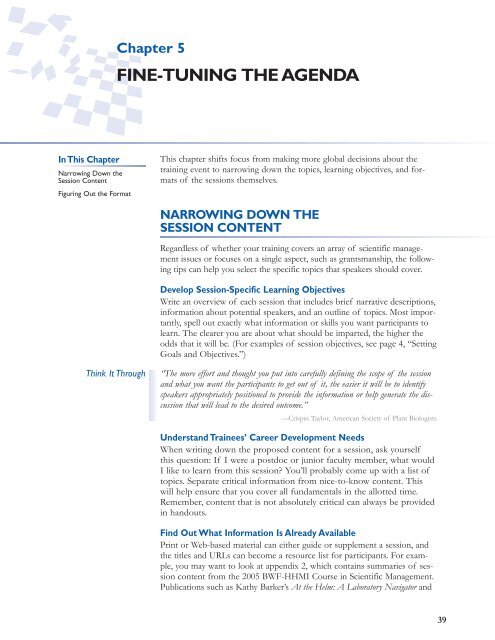Training Scientists to Make the Right Moves - Howard Hughes ...
Training Scientists to Make the Right Moves - Howard Hughes ...
Training Scientists to Make the Right Moves - Howard Hughes ...
Create successful ePaper yourself
Turn your PDF publications into a flip-book with our unique Google optimized e-Paper software.
Chapter 5<br />
FINE-TUNING THE AGENDA<br />
In This Chapter<br />
Narrowing Down <strong>the</strong><br />
Session Content<br />
Figuring Out <strong>the</strong> Format<br />
This chapter shifts focus from making more global decisions about <strong>the</strong><br />
training event <strong>to</strong> narrowing down <strong>the</strong> <strong>to</strong>pics, learning objectives, and formats<br />
of <strong>the</strong> sessions <strong>the</strong>mselves.<br />
NARROWING DOWN THE<br />
SESSION CONTENT<br />
Regardless of whe<strong>the</strong>r your training covers an array of scientific management<br />
issues or focuses on a single aspect, such as grantsmanship, <strong>the</strong> following<br />
tips can help you select <strong>the</strong> specific <strong>to</strong>pics that speakers should cover.<br />
Develop Session-Specific Learning Objectives<br />
Write an overview of each session that includes brief narrative descriptions,<br />
information about potential speakers, and an outline of <strong>to</strong>pics. Most importantly,<br />
spell out exactly what information or skills you want participants <strong>to</strong><br />
learn. The clearer you are about what should be imparted, <strong>the</strong> higher <strong>the</strong><br />
odds that it will be. (For examples of session objectives, see page 4, “Setting<br />
Goals and Objectives.”)<br />
Think It Through<br />
“The more effort and thought you put in<strong>to</strong> carefully defining <strong>the</strong> scope of <strong>the</strong> session<br />
and what you want <strong>the</strong> participants <strong>to</strong> get out of it, <strong>the</strong> easier it will be <strong>to</strong> identify<br />
speakers appropriately positioned <strong>to</strong> provide <strong>the</strong> information or help generate <strong>the</strong> discussion<br />
that will lead <strong>to</strong> <strong>the</strong> desired outcome.”<br />
—Crispin Taylor, American Society of Plant Biologists<br />
Understand Trainees’ Career Development Needs<br />
When writing down <strong>the</strong> proposed content for a session, ask yourself<br />
this question: If I were a postdoc or junior faculty member, what would<br />
I like <strong>to</strong> learn from this session? You’ll probably come up with a list of<br />
<strong>to</strong>pics. Separate critical information from nice-<strong>to</strong>-know content. This<br />
will help ensure that you cover all fundamentals in <strong>the</strong> allotted time.<br />
Remember, content that is not absolutely critical can always be provided<br />
in handouts.<br />
Find Out What Information Is Already Available<br />
Print or Web-based material can ei<strong>the</strong>r guide or supplement a session, and<br />
<strong>the</strong> titles and URLs can become a resource list for participants. For example,<br />
you may want <strong>to</strong> look at appendix 2, which contains summaries of session<br />
content from <strong>the</strong> 2005 BWF-HHMI Course in Scientific Management.<br />
Publications such as Kathy Barker’s At <strong>the</strong> Helm: A Labora<strong>to</strong>ry Naviga<strong>to</strong>r and<br />
39
















